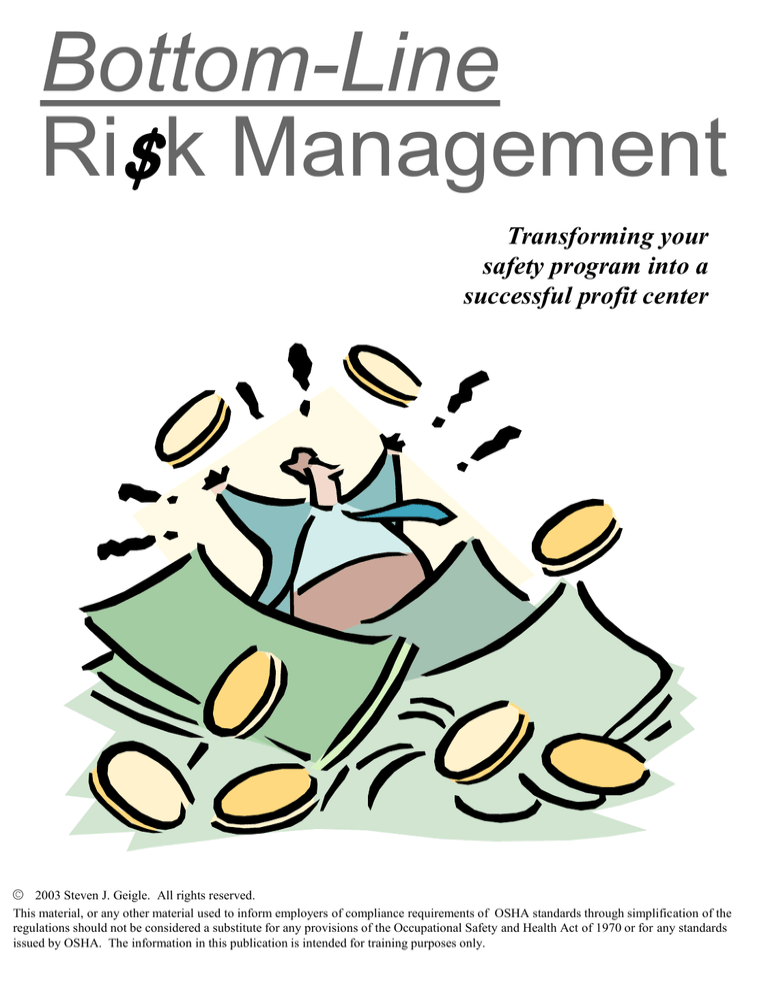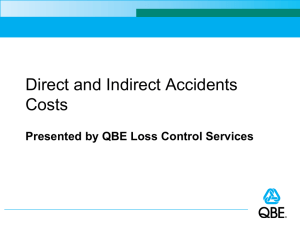
Bottom-Line
Risk
$ Management
Transforming your
safety program into a
successful profit center
©
2003 Steven J. Geigle. All rights reserved.
This material, or any other material used to inform employers of compliance requirements of OSHA standards through simplification of the
regulations should not be considered a substitute for any provisions of the Occupational Safety and Health Act of 1970 or for any standards
issued by OSHA. The information in this publication is intended for training purposes only.
Goals
Part One: Understand...
• The direct, indirect and unknown costs
associated with workplace accidents
• The benefits of paying for safety proactively
• The tools and techniques to measure those
costs and benefits
Part two: Be able to...
• Estimate direct and indirect costs of an
accident
• Determine the potential risk: probability and
severity of an accident
• Complete a cost/benefit analysis including
return on investment, business volume and
units required to cover costs, payback
period, and costing-back.
Bottom Line Safety
2
Form Groups
Introductions
Elect a group leader
Select a spokesperson
Bottom Line Safety
3
Why do employers “do” safety?
The Legal Imperative
The Fiscal Imperative
The Social Imperative
Bottom Line Safety
4
Workers Compensation Basics
How are rates determined?
Manual rating - Basic rate applied to all industries of
the same type or standard industrial classification (SIC).
Expressed as:
Dollars per $100 dollars of payroll
Example: $3.15 per $100 dollars of payroll.
Experience Rating - used to vary the company’s
own rates, depending on its experience by comparing
actual losses with expected losses.
Bottom Line Safety
5
3.75
Manual Rate
3.00
2.75
2.50
Average
Accident
Rate
Above
Average
Accident
Rate
Below
Average
Accident
Rate
MOD Rate
3.50
1.30
1.20
1.10
1.00
.90
.80
.75
.60
2.00
1.75
1.50
Bottom Line Safety
6
Safety Costs
at
XYZ INC.
Instructions
1. Become familiar with XYZ, Inc. background
information and your group’s assigned scenario.
2. Complete assignment one and stop.
Bottom Line Safety
7
1
4
2
5
3
6
Bottom Line Safety
8
Assignment One:
Determine the nature of the Hazard
• Hazardous Conditions
• Exposure/Work Practices
• Root Cause Factors - Management
systems
• Most Probable Outcome
Bottom Line Safety
9
Assignment Two:
Determine the costs
Budgeted Losses
• Planned
• Direct costs
• Workers compensation
• Medical costs
Unbugeted Losses
• Unplanned
• Indirect costs
• 2-10 x direct costs (severity)
• 5-50 x direct costs (labor/capital investment)
Bottom Line Safety
10
Total Estimated Direct Accident Costs
$ _______________
Total Estimated Indirect Accident Costs:
$ ________________
Indirect to Direct Cost Ratio:
Indirect Costs
Direct Costs
=
______ to 1
Total accident costs
Direct Costs$ + Indirect Costs = $______
Bottom Line Safety
11
Step 1:
Assignment Three:
Prioritize
Determine
the risk Hazards
Risk = Exposure x Probability x Consequences
Using the information from the three charts above
and the risk score formula, determine the risk
associated with your scenario.
Risk Score =
E __ x P __ x C __
Risk Scores
Scenario #1
Scenario #2
Scenario #3
Scenario #4
Scenario #5
Scenario #6
Bottom Line Safety
= _________
= _________
= _________
= _________
= _________
= _________
12
Assignment Four:
Develop corrective actions
Engineering controls
Management controls
• Immediate corrective actions..
Strategies:
Estimated Costs:
• Long-term corrective actions.
Strategies:
Estimated Costs:
Bottom Line Safety
13
Assignment Five:
Determine the Costs/Benefits
Cost/Benefit Analysis Techniques
Return on Investment
ROI =
Total Estimated Accident Costs
Total Investment
Using the formula, determine ROI for the
corrective actions your group developed.
Bottom Line Safety
14
Business volume required to cover cost
Volume = Cost of Loss
Profit Margin
Determine the business volume required
to cover the cost of the potential
accident which might occur in your
scenario.
Bottom Line Safety
15
Units required to cover costs
Units Required = Business Volume
Unit Selling Price
Determine the number of humidifiers that
must be produced to cover potential
accident costs.
Bottom Line Safety
16
Payback Period
Payback Period =
Total Investment
Potential Accident Costs
Determine the payback period for the
corrective actions for your scenario.
Bottom Line Safety
17
Assignment Six:
Determine the adjusted profit margin
What will be the impact on XYZ, Inc. if
management does not take action on these
hazards?
Total estimated accident costs for all scenarios
Scenario #1
Scenario #2
Scenario #3
Scenario #4
Scenario #5
Scenario #6
=
=
=
=
=
=
Total
$ __________________
$ __________________
$ __________________
$ __________________
$ __________________
$ __________________
$ __________________
Annual net profit
Total accident costs
Adjusted net profit
$1,200,000
- $ __________
$ __________
Adjusted net profit margin
Adjusted net profit
Annual Business Volume
Bottom Line Safety
= ________
= ________ %
18


